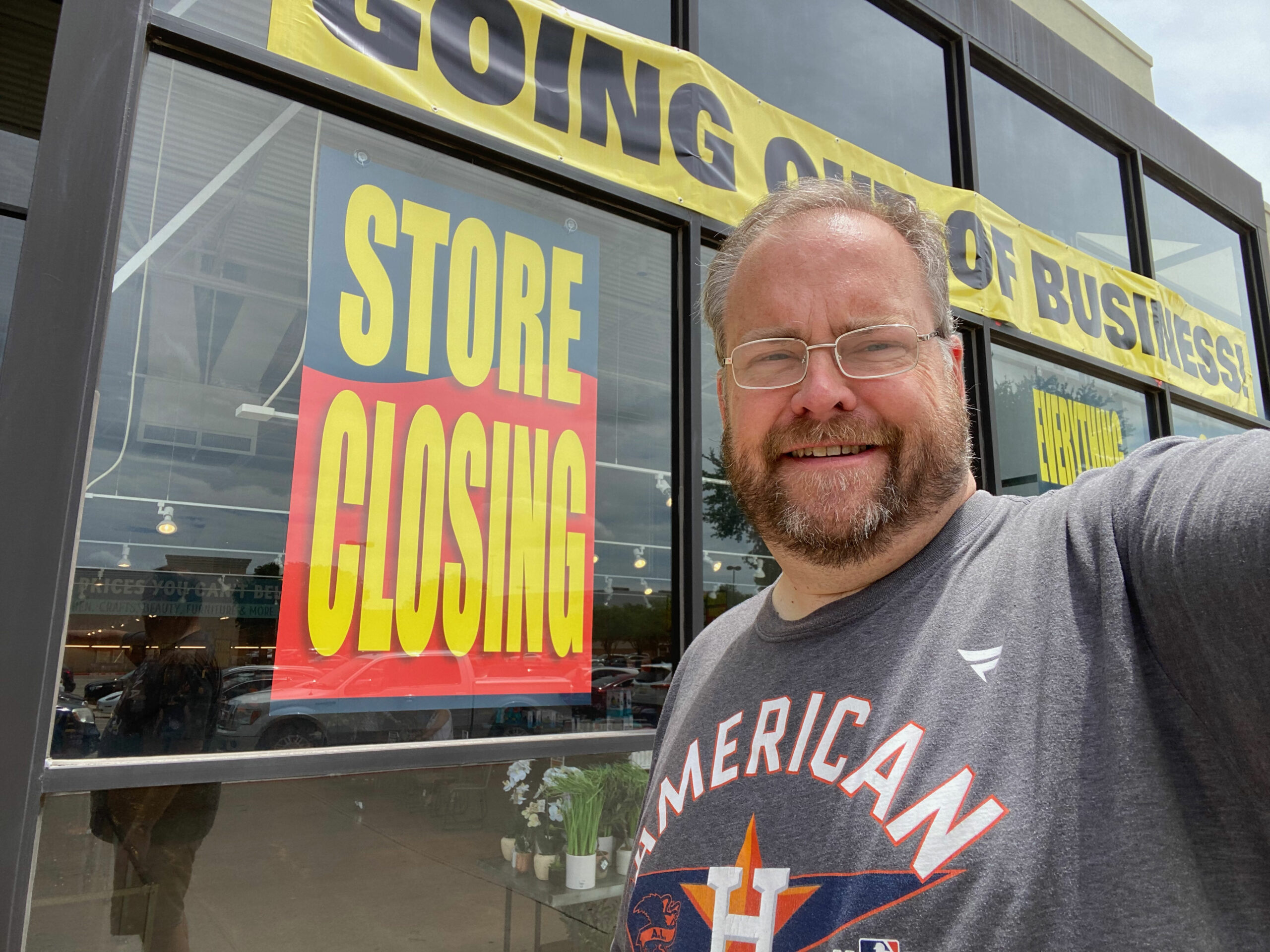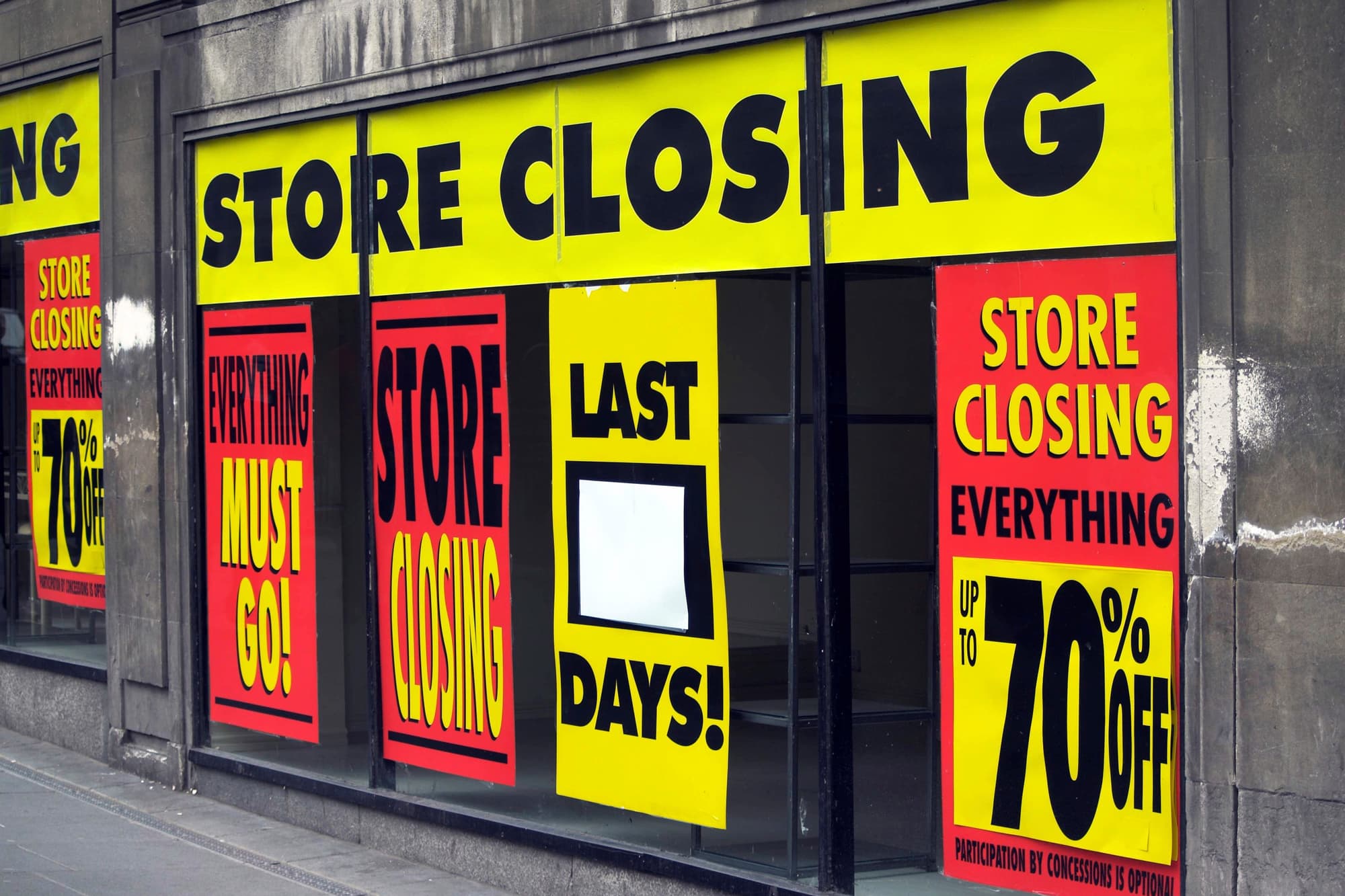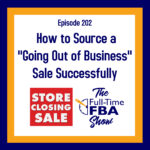Since 2020, increasing numbers of brick-and-mortar retail stores have gone out of business. When this happens, it’s often accompanied by a huge “Store Closing Sale,” where the store is shutting its doors and you’ve got one last chance to get some really good deals. You might be asking yourself: what can resellers do to take advantage of this particular situation? Well, you’re in luck! Today, we share 8 strategies that will help you source a going-out-of-business sale successfully. From understanding how discounts are staggered to finding the best-selling items, making sales before the Amazon market is flooded, and more, this episode is full of practical advice to help you make the most of the next closing-down sale near you!
Listen on the podcast player below.
Like what you hear? Tell a friend… and be sure to leave us a rating and a review. Here’s how.
Key points from Episode 202:
- Tips
 for proactively finding out which stores will be closing their doors near you.
for proactively finding out which stores will be closing their doors near you. - How you can benefit by signing up for store specific email newsletters.
- The importance of understanding storewide clearance sale strategies.
- Why you should only source items that you’re confident will sell quickly.
- How Keepa can help you take advantage of higher sales velocity.
- Advice for scanning the less-prominent shelves for top sellers.
- Why you shouldn’t be afraid to ask the store manager for a bigger discount.
- Reasons to prep and ship inventory to Amazon as soon as possible.
Links and resources mentioned in this episode:
 ‘Complete List of Stores Closing in 2023’
‘Complete List of Stores Closing in 2023’- ‘List of Retail Company Bankruptcies & Closing Stores’
- ‘When discounts mean death: These are the top 10 retail chains closing stores in 2023’
- Keepa
- Email a screen shot of your Full-Time FBA Show podcast review to be entered into our review contest.
Right-click here and save as to download this episode to your computer.
![]()
 THE FULL-TIME FBA
THE FULL-TIME FBA
COACHING PROGRAM
Selling on Amazon sounds easy… but it’s not. Too many Amazon reseller “gurus” will try to get you to fall for an Amazon reseller “get rich quick” scheme, but we’re here to tell you the truth:
- Selling on Amazon is hard, especially when you’re all by yourself… BUT it’s so much easier with a guide — and we’re here to help.
- Selling on Amazon is not a “get rich quick” scheme… BUT it can be a “get rich slowly” plan. With commitment to working hard, combined with our expert guidance, you can start making a full-time income selling on Amazon within about a year.
That’s why you’re invited to join our 12-month long Full-Time FBA Coaching Program. No matter if you’re brand new to selling on Amazon or if you have a few years of experience, our coaching program will take you from where you are to making a full-time income in about 12-months.
Find out more about The Full-Time FBA Coaching Program (including how to set up a Connect Call with me to ask your specific questions about the program).
Back to the main page for The Full-Time FBA Show
More Episodes from the Full-Time FBA Show podcast:
Don’t miss an upcoming episode! Subscribe, download episodes, and review the Full-Time FBA Show:
-
-
- Subscribe on iTunes
- Follow on Spotify
- Follow on Amazon Music (or just ask Alexa to “play The Full-Time FBA Show podcast”)
- Follow on iHeartRadio
- Subscribe on Podbean
- Subscribe on Podbay
- Subscribe on Podchaser
-
![]()
Episode 202 Transcript:

[INTRODUCTION]
[0:00:01.8] ANNOUNCER: Welcome to The Full-Time FBA Show. In each episode, it’s our goal to help you turn part-time hours into a full-time income, selling almost anything on Amazon. Now, your hosts of the show, Stephen and Rebecca Smotherman.
[WELCOME]
[0:00:21.9] STEPHEN: Welcome to episode number 202 of The Full-Time FBA Show. Today, we’re going to be talking about how to source a going-out-of-business sale or store-closing sale. You know those types of sales where, the store is shutting down the doors and one last chance to get some stuff, add some really good deals.
We’re going to talk about how to do that, and to talk about it with me is my wife, Rebecca. What’s up, Rebecca?
[0:00:43.9] REBECCA: Hey there, looking forward to getting into this topic. It’s something that we like to take advantage of from time to time and we want to share our insights with you.
[0:00:54.1] STEPHEN: Yeah, so we are going to talk about that today so let’s get into it.
[DISCUSSION]
[0:01:01.0] REBECCA: Every so often, retail store chains go out of business and since 2020, more and more brick-and-mortar stores have gone out of business than ever. In 2023 alone, more than a dozen major retailers have already said they will close their US stores in 2023 and we’re only in August.
That’s a combined total of almost 2,400 locations this year alone. With that said, it’s pretty probable that you’re either seeing or will soon see some big-name stores near you closing down with a huge going-out-of-business sale.
So, Stephen, let’s get into it, what can resellers like us do to take advantage of this particular situation?
[0:01:42.0] STEPHEN: So there’s eight things that we’re going to focus on in this episode today and the first one is to find out which stores near you are actually going to be closing down. I mean, some of these stores are going to make national news. I mean, you know, a few years ago, when Toys R Us shut down, that made national news and so almost everybody knew about that.
But other stores, you’re going to need to find some other ways to figure out which stores are going to be closing down. Some of you will see obvious signage or advertisements about these store sales but, usually, you’re going to want to be more proactive about finding these store-closing sales much sooner.
In fact, if you wait to hear about it in the news or something, it’s probably going to be too late to take advantage of it. So to do so, to find out and be proactive about finding these going out of business sales, I mean, do a quick Google search for stores going out of business or store closings or store liquidation sales, storewide clearance, things like that, and you should see which stores are closing down.
Now, this morning, I did a search for stores going out of business and the top search results were, “Complete list of store closings in 2023.” Also, “A list of retail company bankruptcies, and store closings,” and then the third one, “Here are the top 10 retail chains closing stores in 2023.” So you can check out those and see if any of those stores are actually near you, then make a plan to source those stores as soon as possible.
[0:03:01.6] REBECCA: The second thing that you can do is get on the email list of the stores that you know are going out of business. It’s important to understand that most going-out-of-business sales last about 12 weeks, from first announcing the store closure to the actual last day the store is open for business. One of the best ways to know when the big sales start is to get on the email list of the stores.
We’ve said it before but we’ll say it again, to save yourself from tons of annoying emails, don’t use your regular email address to sign up for store email lists. Instead, you’ll want to create a business-only email address that you can check from time to time. Just don’t forget to check these emails often enough to make it worth doing and then when the stores plan their going-out-of-business sale, those on the email list will be the first to know about them and that will include you.
[0:03:48.3] STEPHEN: Yeah. The number three thing to make the most out of a going-out-of-business sale is to understand how the storewide clearance has their strategy. So usually, their stores will start their savings small you know, like 10% off select items. Usually, it’s not big enough for resellers but I do want to let you on a little-known sourcing secret that I’ve found to be very true. Even though the items might just be 10% starting off, you can still find stuff that’s really profitable to resell on Amazon.
Yeah, you might not fill up a cart but, if you have the time, these 10% off sales are going to be pretty good. Most people like to wait until it’s like 80% to really make a killing but you can do really well with a 10% off with your time and energy put into sourcing.
After that, with the clearance process being about 12 weeks, you know, it will be about a low 10% off for the first three weeks or so. But then after that, the store will start to advertise up to 30% off, which means that the store will put a very limited number of items at the 30% off, and while there’s most of the rest of the store is still at 10% or maybe 20% off. Just don’t fall for the trap of assuming everything in the store is 30% off when they advertise “up to” 30% off. You know, put the 30% off in huge letters on all the advertisements and all the signage but the words “up to,” they’re really, really teeny-tiny.
Usually every week after that, the percentage starts to get bigger and bigger. Once you start seeing the store fixtures being sold, you know the store shelves, and carts, and displays, and stuff like that, then you’re usually entering in like the final four weeks of the store closure. So that’s kind of how most stores handle clearance sales when it comes to going out of business.
[0:05:27.2] REBECCA: The fourth thing we want to make sure that you know is that when you’re sourcing at a going-out-of-business sale, it’s important to only source items that you’re confident will sell quickly. The reason for that is that if the store near you is going out of business and it’s a chain store and then it’s possible that dozens or even hundreds of those stores across the country are also going to be going out of business.
It might be that Amazon is about to be flooded with inventory from the dozens or hundreds of other resellers who are out there sourcing those going-out-of-business sales with you. So, this is not a time for you to be sourcing long-tail items. Those are items that take a long time to sell. This is a time that you only want to source items that you’re confident will sell quickly.
[0:06:13.6] STEPHEN: Yeah, absolutely. What Rebecca just said, it’s so true and so important. Only source the items that you’re confident are going to sell quickly, which moves us into our next tip, Unless it’s really close to Q4, then you can kind of expand your parameters on how fast an item needs to sell in order to be worth sourcing. This is where our good friend, Keepa, comes back into play.
Remember, Keepa is the tool that tracks sale rank history, pricing history of almost every item on Amazon. Well, you can see with Keepa, the sales velocity of the item that you’re going to source at this going-out-of-business sale, and if it ramps up during Q4, then maybe you don’t need to only source the items that you expect to sell very quickly because the quicker sales, they’re going to be coming come November and December.
So, just be sure that you have Keepa confirmed, that you can expect higher sales velocity come Q4 before you expand your sourcing parameters.
[0:07:06.4] REBECCA: Our sixth piece of advice for you with going out of business sales is that you don’t ignore items in less prominent locations of the store. So usually, the store that’s going out of business is going to put their less popular items in the most prominent places and give them the most visible shelf space. This means that the items people want more are probably on the bottom shelves or the very top shelf, or in the back corner of the store.
These stores know what their best sellers are and they know they don’t have to work hard to sell out of these best sellers. So they usually get the worst shelf space in this situation. So make sure you’re not just visually scanning the store using your eyeballs to look around and see what jumps out at you but look everywhere for items that you can flip on Amazon.
[0:07:52.6] STEPHEN: The seventh thing we want to talk about, and this might be a little bit outside of your comfort zone, but if you notice that you’re finding a lot of stuff to buy for resale, ask a store manager or the area manager if you could get an additional percentage off, maybe if you buy multiple carts full or if you clear the shelf. You might be surprised how eager these managers are to sell as much stuff as possible as fast as possible.
Also, they might agree just because, I mean, they’re probably losing their job after the store closes and they don’t care if the store makes a profit. They just want to get the stuff gone so they might give you an additional percentage off the already clearance prices if you just ask. I mean, the worst they can say is no.
[0:08:29.3] REBECCA: Yeah, they don’t want to have to do any more inventory or put any more price stickers on anything.
[0:08:34.2] STEPHEN: Absolutely.
[0:08:34.7] REBECCA: They want to get rid of it. All right, so the number eight and final piece of advice we have for you is that, once you’ve purchased your inventory from a store that’s going out of business, prep that inventory and ship it to Amazon as soon as you can.
Like I said, if a store’s going out of business and it’s a chain store that’s all across the country, then there’s going to be all these other sellers who are also trying to get their inventory in and time is of the essence at this point. You want to make sure that you’re getting some sales before the market is flooded with that same inventory.
You want to get your stuff to Amazon FBA warehouses first so that you get the first and fastest sales.
[0:09:14.0] STEPHEN: So those are the eight strategies, eight things that you need to know when going into and taking advantage of a going-out-of-business sale. So, it kind of stinks that these stores are going out of business but it gives us an opportunity, one last chance to source the store for inventory to sell on Amazon and to be able to make some profits while we say goodbye to some of the stores that we’ve seen for a long time and maybe even sourced at for a long time. I know when Tuesday Morning went out of business, you know, it was a little – not emotional but like you know, I –
[0:09:44.5] REBECCA: It was sad.
[0:09:45.4] STEPHEN: It was sad and so yeah, finding stuff there for a long time was a lot of fun and that opportunity is now gone. I had one last hoorah with the Tuesday Morning going-out-of-business sale and some of these stores, you can have the last hoorah with that store as well.
As we’re closing up this episode, I want to remind you that a few weeks ago, we announced a review contest. We’re doing a review contest, we’re giving away some really cool stuff for people who leave us a review. You just go find your favorite podcast player, you’re probably on it right now, and leave us an honest review about the podcast and then take a screenshot of it and send it to us, stephen@fulltimefba.com.
That’s S-T-E-P-H-E-N@fulltimefba.com and that will be the proof and your entry into the contest. We’ll pick a random winner and we just appreciate you and we appreciate your reviews. So leave us a review and you have until the end of the month, the end of August to enter and it will be fun.
[CLOSING CONVERSATION]
[0:10:44.4] REBECCA: Thank you so much for joining us for this episode of The Full-Time FBA Show. As a reminder, we always have the transcript and the show notes for you at fulltimefba.com/202 because this is episode number 202.
[0:10:55.7] STEPHEN: That’s right. And, next week, we’re going to talk about how to transition from sourcing one-offs to sourcing replens and how it can lead to a longer-lasting successful Amazon business. We’ll talk about that next week on The Full-Time FBA Show.
[OUTRO]
[0:11:12.5] ANNOUNCER: That is all for this episode of The Full-Time FBA Show. So head over to fulltimefba.com/podcast, where you will find the show notes and links from this episode. While you’re there, subscribe to our newsletter where you’ll get several free downloads of our popular and helpful Amazon FBA resources. Now, take action on what you have learned today, so you can find success at turning part-time hours into a full-time income with Amazon FBA.
[END]


Leave a Reply